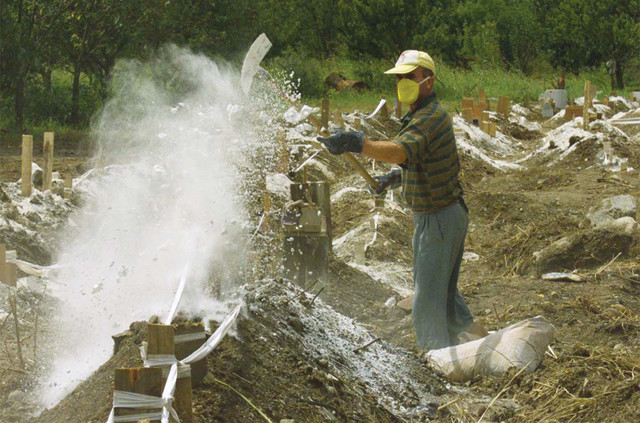
by U.S. Geological Survey Thursday, June 14, 2018
M. Michael Miller, a mineral commodity specialist for the U.S. Geological Survey, has compiled the following information on lime, a widely used chemical product.

Fearing the spread of disease following an earthquake in Turkey in 1999, officials spread lime on the graves of victims to speed up decomposition. Credit: AP Photo/Dimitri Messinis
“Lime” is not itself a mineral and is never found in a natural state. Instead it is a commercial product used for millennia in everything from building construction to paper-making to fertilizer.
Though the term “lime” is often used as an abbreviated or traditional term for limestone, it actually describes a caustic chemical manufactured from limestone or other calcium carbonates in a kiln at temperatures ranging from 925 to 1,350 degrees Celsius. Because of the chemical differences in limestones, a rigid standardization of lime material specifications is impossible.
The burning, or calcination, process drives off the carbon dioxide, leaving calcium and magnesium oxides — or quicklime. Adding water to the process creates a hydroxide — or hydrated or slaked lime.
Lime is widely used in steelmaking, where it is effective in removing phosphorus, sulfur and silica, and in the recovery of many nonferrous ores, especially copper and gold. Lime is also used in paper production, and is used to manufacture a type of filler widely used in white paper. It is also used in the treatment of smokestack emissions from coal-burning power plants to capture sulfur dioxide, and in the treatment of drinking water, wastewater and sewage sludge.
For millennia, lime has been used in the building trades industry, where it still is used in mortars and plaster. However, owing to its faster setting times and greater strength, in recent years, portland cement has largely replaced lime in this area. Lime is still widely used in constructing roads and highways, as it helps stabilize the soils. Adding lime to the soils improves their engineering properties, thus providing a solid working platform for the construction of safe and enduring roads. Other uses of lime include acid-waste neutralization, agriculture, chemical manufacturing, food preparation, oil and gas drilling, and tanning.
There is only limited international trade in lime, largely because most countries contain deposits of carbonate rocks suitable for lime production and lime itself is a relatively low-value product. Furthermore, lime cannot be stockpiled for more than six months because it absorbs carbon dioxide and changes chemically, and quicklime reacts with water, making bulk transport difficult.
Visit minerals.usgs.gov/minerals for more information on lime and other mineral resources.
World lime production is on the order of 280 million metric tons annually, with China accounting for an estimated 170 million tons.
In 2007, the United States produced 20.2 million metric tons of lime and consumed 20.4 million metric tons (imports were about 1 percent of U.S. consumption).
Major lime-producing states include Alabama, Kentucky, Missouri, Ohio, Pennsylvania and Texas.
Lime use probably dates back 4,000 to 6,000 years — the ancient Egyptians used lime as an ingredient in mortar and plaster.
The primary use of lime was in construction until the rapid growth of the chemical process industries at the beginning of the 20th century, when it found usage as a chemical reagent in a number of environmental, agricultural and industrial applications.
Lime is spread on decomposing bodies to help fight the spread of disease from epidemics, plagues and disasters by accelerating the decomposition.
Some researchers propose adding lime to seawater in great quantities to absorb and reduce atmospheric carbon dioxide.
© 2008-2021. All rights reserved. Any copying, redistribution or retransmission of any of the contents of this service without the expressed written permission of the American Geosciences Institute is expressly prohibited. Click here for all copyright requests.